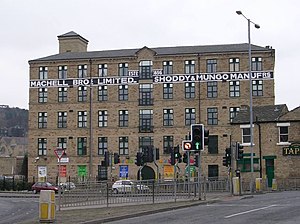Heavy Woollen District

The Heavy Woollen District is a region of textile-focused industrial development in the West Riding of Yorkshire. It acquired the name because of the heavyweight cloth manufactured there from the early 19th century.[1]
The district spreads over an area encompassing Wakefield, Dewsbury, Batley and villages out to Leeds.[2] Its manufactures filled these towns, and also Liversedge, Gomersal, Gildersome, Birkenshaw, Mirfield, Cleckheaton, Morley, Tingley, East Ardsley, Birstall and Horbury. The manufacture of wool cloth for clothing, blankets, rope and twine continues in the district.
The area was one of the key textile centres in Yorkshire, famed for its production of "shoddy and mungo".[3] For years companies had tried to blend different fibres without success leading to the term, "munt go", i.e. "mustn't go" as a Yorkshire colloquialism. Machinery invented in Batley to grind soft rags (shoddy) is thought to have first been devised in 1813,[4] and for hard rags (mungo) later on. Most mills have either closed or put to other uses, but some shoddy/mungo mills remain such as Edward Clay & Son Ltd. in Ossett.

History
The Heavy Woollen District branch of the General Union of Textile Workers was formed in 1892 to service the needs of the local population. The union produced a publication entitled Heavy Woollen District Textile Record, as a newsletter for distribution to members by the union's local collectors of subscriptions.[5]
Transport
The area was served by the Yorkshire (Woollen District) Electric Tramways between 1903 and 1934, which were replaced with buses operated by Yorkshire Woollen District Transport company.
Sport
There is still a Heavy Woollen District football association and junior cricket association,[6][7] both with representative teams. The cricket league originally defined the district as within a six-mile radius of Batley Town Hall, but this was extended to an eighteen-mile radius. The 'Heavy Woollen District Cricket Challenge Cup' was first competed for in 1883.[8]
Location
- Location map: 53°35’35"N, 1°48’4"W
Outside links
- Memorial to injured soldiers who died at the Heavy Woollen District Military Hospital, Staincliffe, Dewsbury
- Heavy Woollen District Hospital Radio
References
- ↑ "Heavy Woollen District". The Dewsbury Partnership. https://godewsbury.uk/heritage/local-history/.
- ↑ Nostalgia on Tuesday: Rise of the tram The Yorkshire Post, 13 June 2017. "...to feed the heavy woollen districts of Thornhill, Ravensthorpe, Heckmondwike, Batley, Liversedge, Hightown, Moorend and Birkenshaw." Retrieved 29 March 2021
- ↑ Shell 2020.
- ↑ Shell 2020, pp. 26–27.
- ↑ Turner, Ben. Heavy Woollen District Textile Workers Union, 1917. A short account of the rise and progress of the Heavy Woollen District branch of the General Union of Textile Workers. p.18, p.76, p.79 Printed by the Yorkshire Factory Times. via Huddersfield Exposed Retrieved 4 April 2021
- ↑ Bleakley, John (29 April 2013). "HWDFA U17 Representative Football". Pitchero.com. http://www.pitchero.com/clubs/hwdfaminors/.
- ↑ Heavy Woollen District Junior Cricket League
- ↑ "History of the Heavy Woollen". Heavy Woollen District Junior Cricket League. http://www.heavywoollen.org.uk/history.htm.
- Shoddy: From Devil's Dust to the Renaissance of Rags. University of Chicago Press. 2020. ISBN 9780226377759.
- "The Woollen and Worsted Industries". Journal of the Royal Society of Arts 57 (2941): 414. 1909.